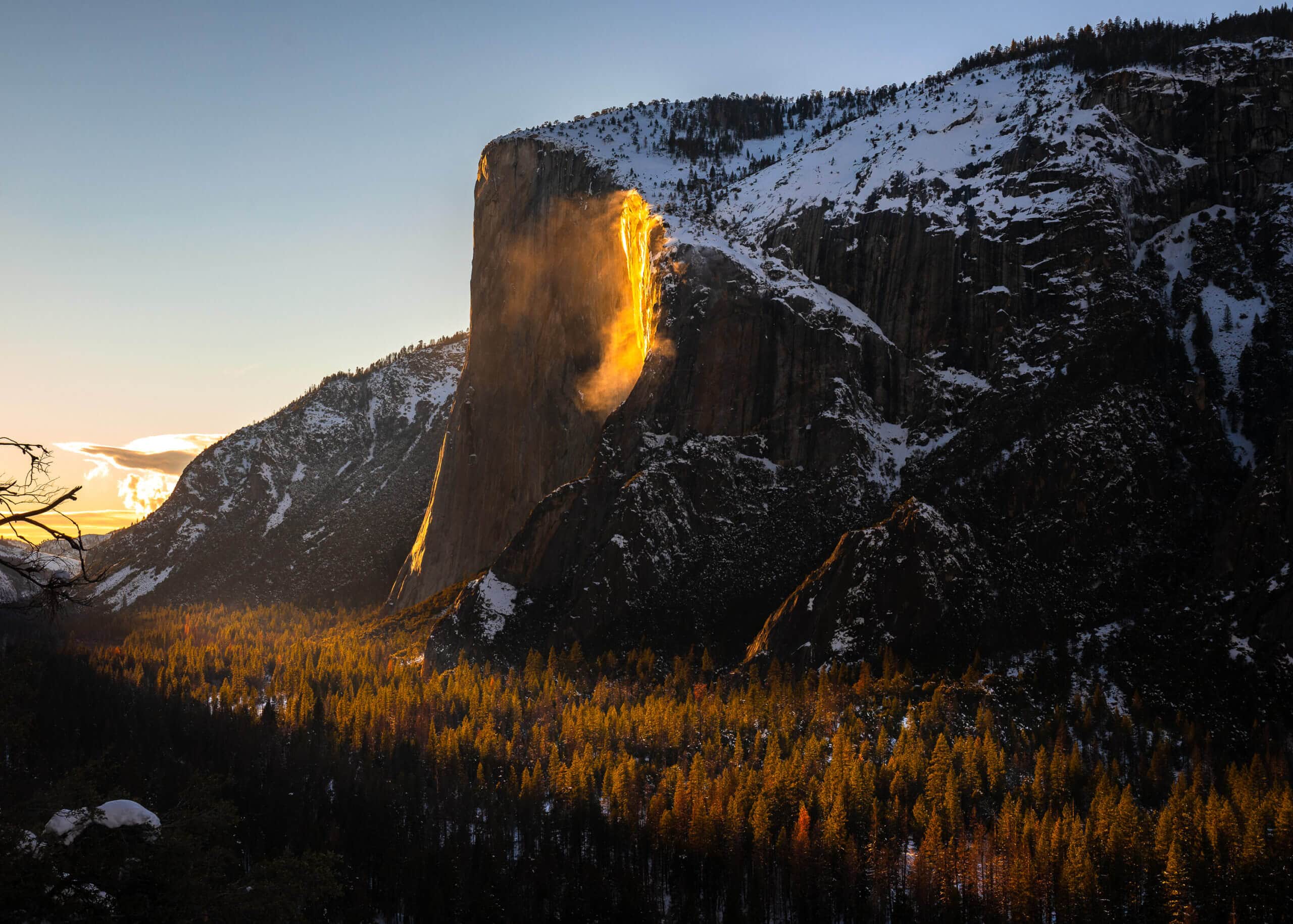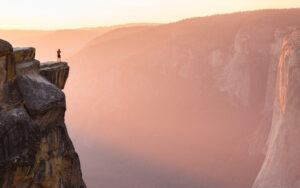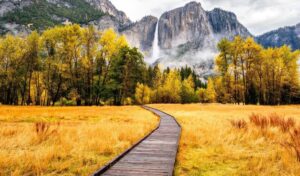Hundreds of photographers gather in Yosemite Valley each year for the natural Firefall at Horsetail Fall.
Everyone there has their fingers crossed for the perfect conditions. When it happens, the sunlight streams through the thin sliver of Horsetail Falls, turning it molten orange. Shutters fire as people gasp, cheer, and hug their friends and neighbors.
Here is what you need to know about this otherwise humble waterfall in 2025, and how to catch it in full sensation mode.
When to see Yosemite Firefall?
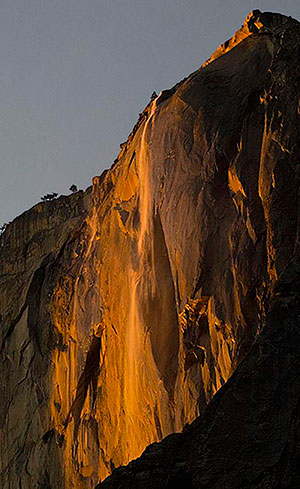
During mid to late February, the waterfall begins to light up 5 to 15 minutes before sunset. However, you should plan to invest several hours to get to the right place in time.
People visit Yosemite National Park from all over the country for the natural Firefall event. That means that they are finding their spot and setting up their tripods earlier and earlier in the day to get just the angle they want. In order to navigate the parking situation and have enough time to walk out to a place where you can see the Firefall, plan to arrive in the valley in the late morning or early afternoon.
Spend the time relaxing and enjoying the already-majestic Yosemite scenery, and get to know the people around you.
2025 Permits and Logistics
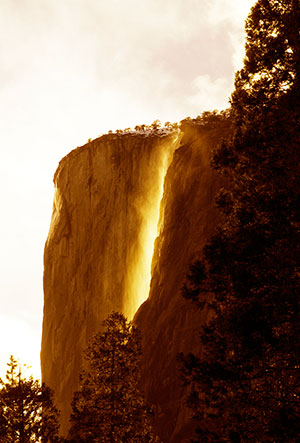
For visitors wishing to view the Natural Firefall at Horsetail Fall, reservations will be required for the following dates in February:
- February 8-9
- February 15-17
- February 22-23
On days when reservations are required, they’ll be needed to enter Yosemite National Park for all visitors without in-park lodging or camping accommodations, 24 hours a day. Visitors with in-park lodging or camping reservations in areas such as Yosemite Valley, Wawona, Foresta, or Yosemite West do not need to make a vehicle reservation to enter the park.
The first 50% of vehicle reservations for all required dates will become available at 8 am PST on November 18, 2024. The remaining 50% of reservations will become available two days prior to the reservation date. For example, on February 21 at 8 am, day-use reservations for February 23 will be available. To make a reservation, click the button below.
Yosemite Firefall Viewing Conditions
Most of the year, Horsetail Falls is one of Yosemite’s less-remarkable waterfalls. Although it drops an impressive 2,130 feet (650 m), the small stream at the top of El Capitan doesn’t have the massive volume of some of the more well-known waterfalls like Yosemite Falls or Bridalveil Fall. Fed exclusively through snowmelt and run-off, it dries up in the summer months and disappears entirely.
However, for a few weeks starting in February, everything comes together to make this humble waterfall into a natural Firefall – Yosemite’s own international celebrity. Several factors go into creating this magnificent spectacle.
1. The perfect alignment of the sun, the waterfall and the viewer
The sun comes into position in mid-to-late February each year, so if you’re in the right place, that’s when the magic will happen.
2. Enough water in Horsetail Fall
The second requirement for the Yosemite fire waterfall effect is having enough water in Horsetail Fall.
In order to get a nice flow in Horsetail Fall a few different things need to happen. One, there has to be some snow on the ground to provide the water for the waterfall. Second, it needs to be warm enough during the day that the sun melts that snow and sends it running over the edge of the fall. If it is exceptionally cold, the cliff surrounding the waterfall will still light up, and the trickle of water coming over the edge will reflect the setting sun, but you won’t see the stream of molten fire unless there is more water.
Check out the Yosemite Falls webcam to get a sense of the water flow in Horsetail Fall before you make the trip. It will give you some idea of how much water is flowing. Also, plan to keep an eye on the Yosemite weather forecast in late January and early February.
3. Clear skies
With the sun in the right place, and enough water in Horsetail Fall to catch the sun, the Firefall can still fail to materialize if cloud cover blocks the sun during the critical minutes of the evening. For that reason, a cloudy forecast will keep many people away. However, if that cloudy forecast clears just enough to let the right beam of sunlight through, you can end up with a one-of-a-kind image with the Firefall surrounded by brilliant pink clouds.
Where to View Firefall at Horsetail falls
There is one designated location to view the natural Yosemite Firefall on the eastern edge of El Capitan on the valley floor. However, keep in mind that thousands of people arrive each year hoping to see Horsetail Fall glowing, so plan accordingly.
The El Capitan Picnic Area is one of the most popular destinations for Yosemite Firefall viewers and is closest to the location where Galen Rowell took that first now-legendary photograph. It’s also one of the closest viewing spots for viewing Horsetail Fall, so if you don’t have a long telephoto lens, this will probably be your best bet.
Where to park for the yosemite firefall
The closest parking to Horsetail Fall is the Yosemite Falls Parking Area near Yosemite Valley Lodge. Since there will only be one lane for traffic during this period, there is no parking, stopping or unloading passengers between Camp 4 and El Capitan during the ‘Firefall season’, though people with a disability placard are allowed to park at the El Capitan Picnic Area. If these parking areas are full, visitors can park at Yosemite Village – a free shuttle transports guests from Yosemite Village to the Yosemite Falls Parking Area at Yosemite Valley Lodge.
On the other side of the Merced River from El Capitan, on Southside Drive, stopping is also prohibited between El Capitan crossover and the Swinging Bridge Picnic Area. The riverbank here was so impacted by visitors in February of 2017 that a large section of the riverbank collapsed into the river. Pedestrians are not allowed to walk on or next to the road, and the area between the road and the river (including the river) is closed to all entry.
Yosemite Firefall History
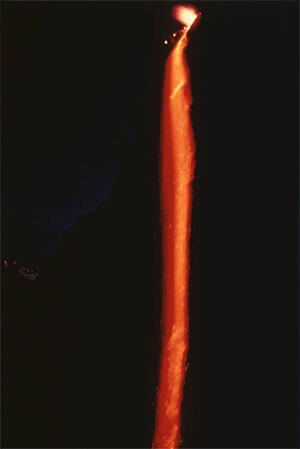
The reason this is called “the Firefall” and not the Yosemite fire waterfall or something else stems from an interesting history of amazing visual displays in Yosemite Valley.
Back in 1872, the owners of the Mountain House Hotel created a spectacle by pushing an actual bonfire off the edge of the cliff at Glacier Point. The cascade of red-hot embers falling down the cliff looked like a glowing waterfall of light to onlookers below. Although the practice started and stopped several times over the years, by the mid-1900s thousands of people were coming to Yosemite to watch the fire fall.
This was the original Yosemite Firefall.
Why did they stop the Yosemite Firefall?
Eventually, in January of 1968 the director of the National Park Service, George Hartzog, stopped this practice. This man-made event was obviously inconsistent with Yosemite’s mission to protect the park’s natural wonders. The huge number of spectators were trampling the meadows, and the concessionaires were having to go further and further afield to find enough of their preferred red fir bark to build the fires. Not to mention the fire hazard it created.
Just 5 years after the Yosemite Firefall ended in 1973, a talented adventure photographer named Galen Rowell accidentally stumbled across a new Firefall-like phenomenon. As he was driving out of the valley on Southside Drive, he spotted a small waterfall off the shoulder of El Capitan that looked molten in the setting sun. He leaped out of his car and ran to take the photograph – the first widely-circulated color picture of the natural Firefall in Yosemite National Park.
With the image of the falling bonfire at Glacier Point a recent memory, of course the new natural phenomenon has been dubbed the natural Yosemite Firefall.
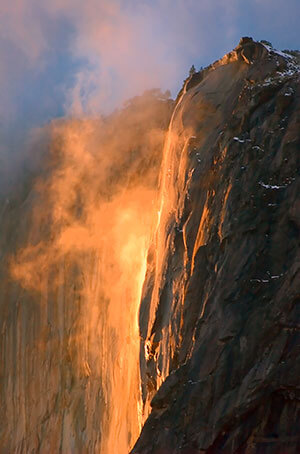
What should i bring to view the firefall at horsetail falls?
Anticipate a long walk from the parking to the viewing areas and plan to spend at least a few hours outdoors in February.
- Flashlight or headlamp. A red LED light is ideal, or you can cover your regular light with red saran wrap so you don’t interfere too much with others’ night vision adaptation.
- Warm boots or other footwear that is also comfortable to walk in.
- A foldable camp chair or an insulated pad to sit or stand on.
- Food and water.
- Extra warm layers – gloves, hat, extra jackets, scarf or even a blanket. Even if the daytime temperatures are relatively mild, you may want those warm layers as the sun starts to set.
- Camera gear for low-light photography
- A camera with a telephoto lens. Most people will have a DSLR with a 200mm plus lens on it.
- A tripod – preferably a nice, sturdy one to hold that big lens.
- A remote or another method to minimize camera shake when taking the photo.
- A friendly and respectful attitude.
- Due to the popularity of this event, you’re likely to end up pretty close to other people who have come for the famous natural Yosemite Firefall. This is a great opportunity to meet people and share stories.
- Everyone is hoping for a great natural show, but don’t be so obsessed with visions of Instagram fame that you forget that you are in a national park. So, from one park-lover to another: Be aware of your impact. Follow the Nature Rules. Try not to trample the vegetation. Practice Leave No Trace. Make sure you don’t leave any trash behind.
While you’re waiting for the perfect conditions to come together for your special Yosemite visit, enjoy this Yosemite Nature Notes video of the natural Yosemite Firefall at Horsetail Fall.

